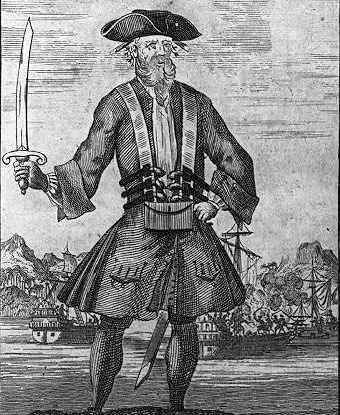Last updated: September 28, 2016
Person
Blackbeard (aka Edward Teach)

Library of Congress
The name Blackbeard is synonymous with pirating in the eighteenth century. Born Edward Teach (or possibly Thatch), he served England as a privateer in Queen Anne’s War until turning to piracy at war’s end in 1713.
His career in piracy began in the Caribbean with fellow pirate Benjamin Hornigold. In 1717, after Hornigold rewarded him with a hijacked ship, Blackbeard set out on his own. Queen Anne’s Revenge, as Blackbeard now called the ship, carried a crew of approximately 300 men and 40 cannon. He and his men sailed the Caribbean and the Atlantic coast of North America, torturing merchant ship crewmen and passengers, stealing cargo, and gaining a reputation as one of the most notorious pirates in history.
In battle, Blackbeard was a savage opponent with a reputation for inhuman strength. In addition, he cultivated his image to strike fear into the hearts of other sailors, wrapping slow-burning lighted coils in his long, black hair and beard.
The image pirates such as Blackbeard cultivated was often just as important as their actions. Flags became an important aspect of that image. In Blackbeard’s case, the flag flying over the Queen Anne’s Revenge depicted a heart dripping blood and a skeleton holding an hourglass and spear. The flag, much like Blackbeard’s personal image, was designed solely to intimidate.
Despite his outlandish persona and reputation as one of the most feared men of the seas, Blackbeard’s time as a pirate was short-lived.
Piracy became rampant in North Carolina after Blackbeard bribed colonial governor Charles Eden to ignore criminal activities. With commercial vessels using Ocracoke Inlet to access inland ports, Blackbeard and several other pirates found the coastal waterway an ideal target.
After tolerating Blackbeard’s terrorism for eighteen months, North Carolina residents and merchant sailors begged Virginia’s colonial governor Alexander Spotswood for help. Acting in secrecy, Spotswood arranged an ambush of Blackbeard, offering a bonus for Blackbeard’s death.
Royal Navy Lieutenant Robert Maynard, the commanding officer of the arranged assault, found Blackbeard in Ocracoke Inlet on November 22, 1718. Maynard’s two ships, Jane and Ranger, were immediately fired upon by Blackbeard and his crew, severely damaging the Ranger. When Jane began to take damage, Maynard ordered the crew to go below deck, creating the illusion of an abandoned vessel.
Blackbeard took the bait. Leading a charge aboard the vessel, he and his men were surprised by Maynard’s crew. Blackbeard suffered twenty-five stab wounds and five gunshots before succumbing to his injuries. He was decapitated, his head hung on the Ranger’s bowsprit, and his body tossed overboard, bringing a literal end to Blackbeard and a symbolic end to Atlantic Coast piracy.
